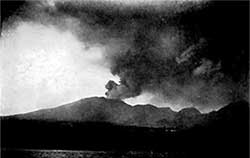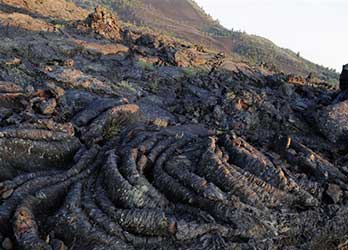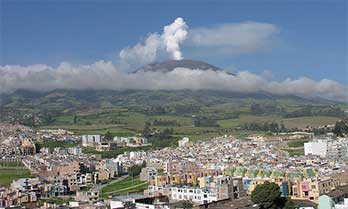Viscosity and Gas
The viscosity of magma (and lava) depends on the percentage of silica, the most common mineral on Earth. As magma melts the chamber walls, it takes on some silica along with other minerals. A 50/50 mix—half silica and half other minerals—will produce a low-viscosity lava, such as basalt. The most viscous lava is rhyolite, typical of supervolcanoes, and contains about 70% to 75% silica. Andesite and dacite, found in subduction zone volcanoes, are in between.
|
Ngauruhoe, located on the North Island, is one of New Zealand’s most active volcanoes. A January 1974 eruption included the nuée ardente captured in this photo. |
Highly viscous magma holds on to its gas more easily than does less viscous lava. This is because it’s harder for the gas to expand and escape a stiff liquid that’s packed with tightly linked silica molecules. The magma viscosity becomes important in determining the explosivity of an eruption.
An eruption begins when the magma chamber is so full and under so much pressure that the rocky plug in the vent can no longer hold back the molten rock. The gassy magma leads the race to the top through a conduit, barreling toward the volcano’s vent and trailed by the less gassy magma. As the pressure on the magma lessens, the gas bubbles out rapidly.
If the magma is viscous, and thus packed with gas, the gas escapes suddenly and with a tremendous explosion—blowing the emerging lava to bits of ash and rock. The explosion can also produce nuées ardentes (“glowing clouds”), which are superheated gases and fragments that surge down a mountain at jet-like speeds. The trailing magma, which has less gas, emerges with less force. This type of eruption occurred at Mount Pelée on the Caribbean island of Martinique in 1902.
|
On May 8, 1902 a violent eruption of Martinique’s Mount Pelée sent a nuée ardente hurtling on top of the city of St. Pierre, killing almost 30,000 people. A photo taken three weeks after the disaster shows the volcano continuing to send up plumes of ashes. |
Sharp, blocky a'a lava forms when the magma has a higher viscosity. |
If the magma is basaltic and thus less viscous, the gas releases more gradually. As a result, the force of eruption is milder, and the lava stays liquid. Undersea volcanoes at rifts gently ooze out basaltic lava. They’re pumped with gas, but the tremendous water pressure at the ocean bottom keeps that gas trapped in the liquid.
|
As the lava flowing from Hawaii’s volcanoes reaches the sea, it cools quickly, releasing water vapor. |
Thick, ropy pahoehoe (pronounced pa-hoy-hoy) lava flows form when the magma has a lower viscosity. Although pahoehoe is a Hawaiian word, the name has been adopted for all similar type flows, like this one at Craters of the Moon National Monument, in Idaho. |
|
|
|||
 |
Digging DeeperFind out more about |
||
|
|
|||
The balance between gas, viscosity, temperature, pressure, and other factors produces a range of volcanic behavior. Sometimes the magma rises but cools, retaining its gases and averting an eruption. Sometimes the magma chamber itself explodes, destroying the mountain.
|
Galeras volcano, in Colombia, erupted suddenly 1993, catching scientists and tourists on the mountain by surprise, with tragic results. |
Volcanologist Stanley Williams and his science team experienced something in between on Galeras volcano in Colombia, South America. On January 14, 1993, scant data of earthquake tremors indicated fresh activity in its belly, but nothing particularly dangerous. In fact, a big explosion never happened that day. Instead, unexpectedly, Williams said the mountain “cleared its throat” just as the scientists finished collecting gases in and around the crater.
The hiccup dislodged a plug of rock blocking a vent, unleashing a local but deadly shower of TV-sized boulders. Like ants in a Texas hailstorm, the scientists were dwarfed and helpless, even by this relatively minor blast. Williams barely survived his critical injuries, but six scientists and three tourists lost their lives.
In the face of such power, human beings have only one defense: predicting eruptions.
This content has been re-published with permission from SEED. Copyright © 2024 Schlumberger Excellence in Education Development (SEED), Inc.







